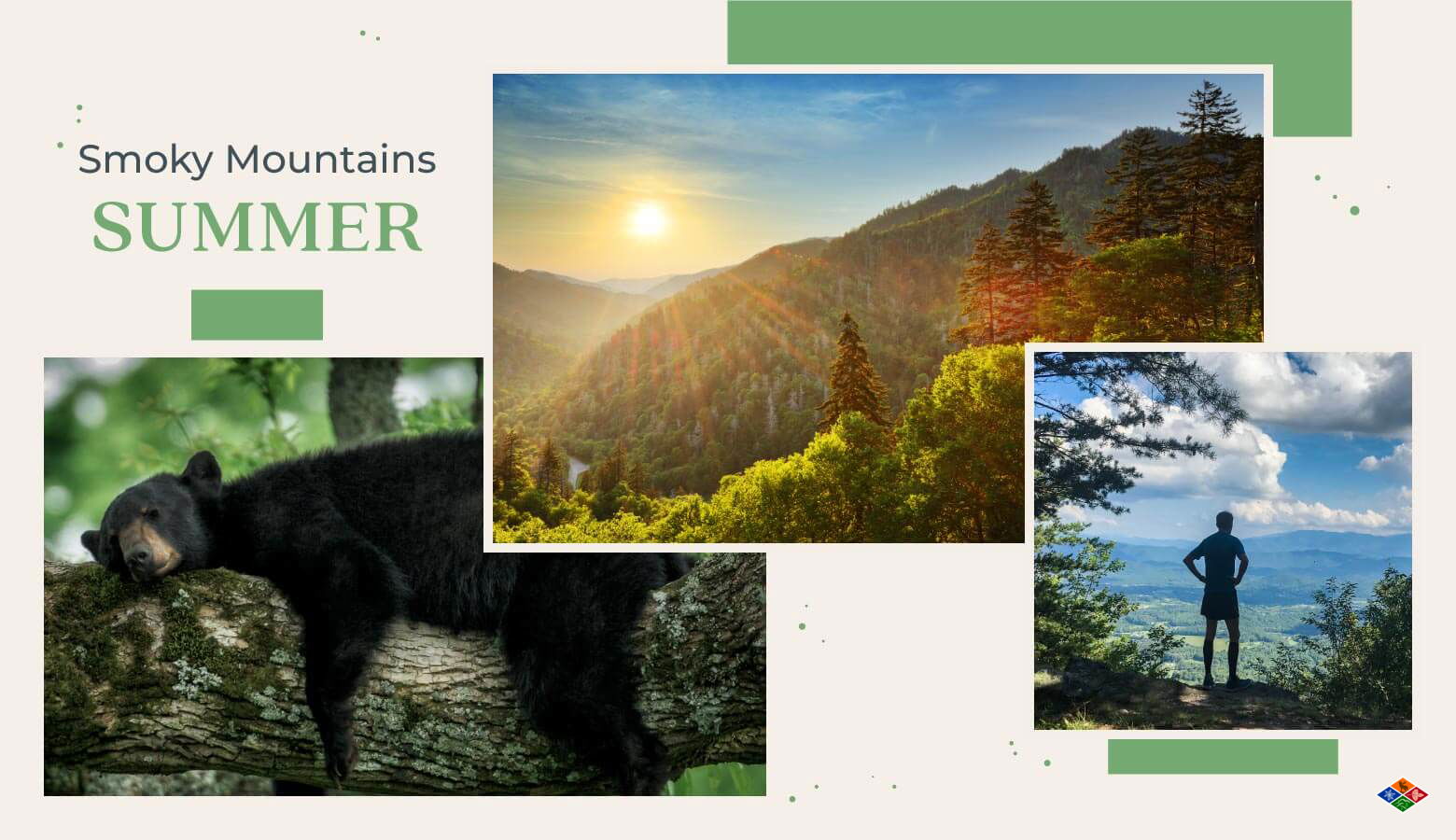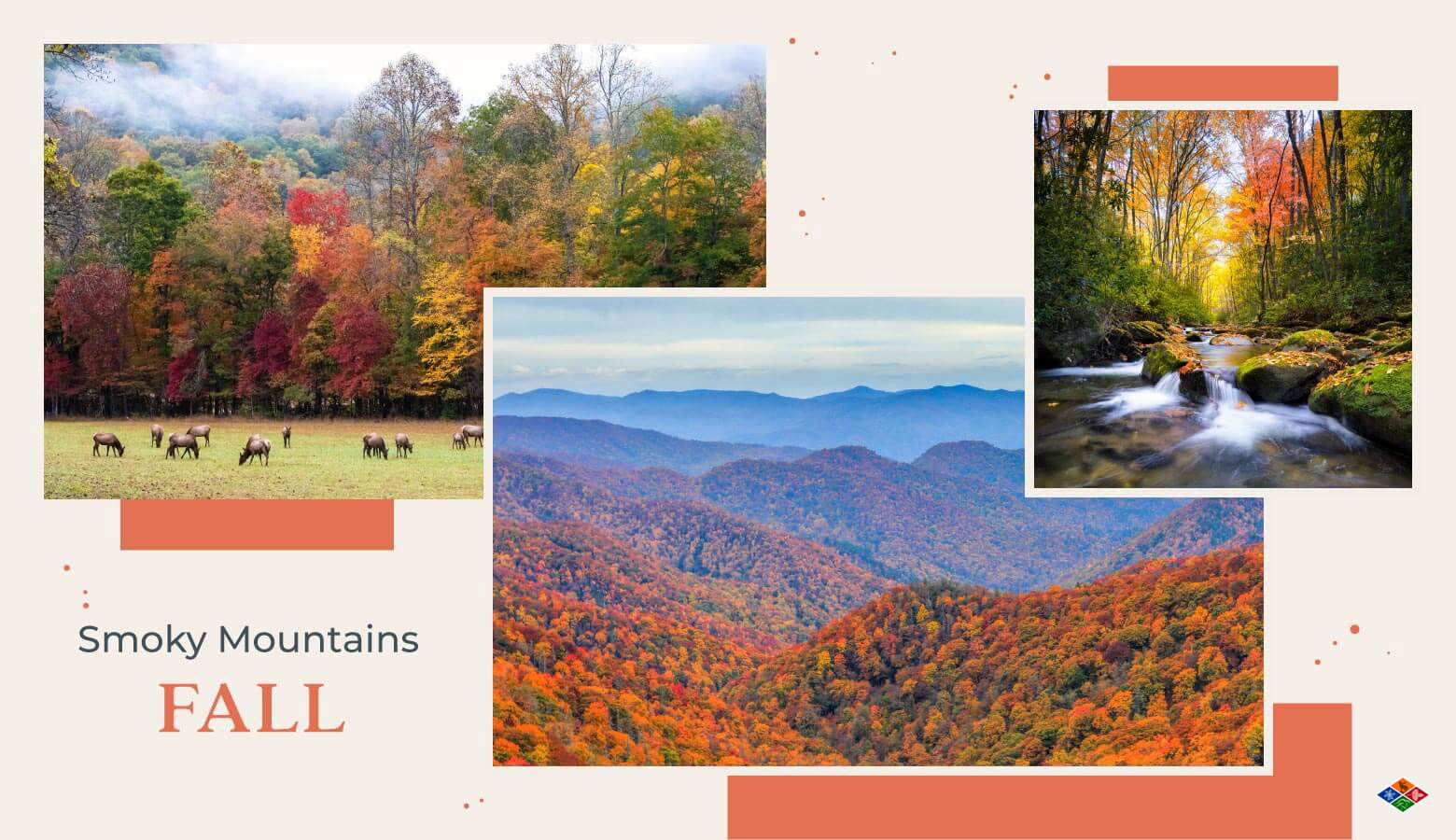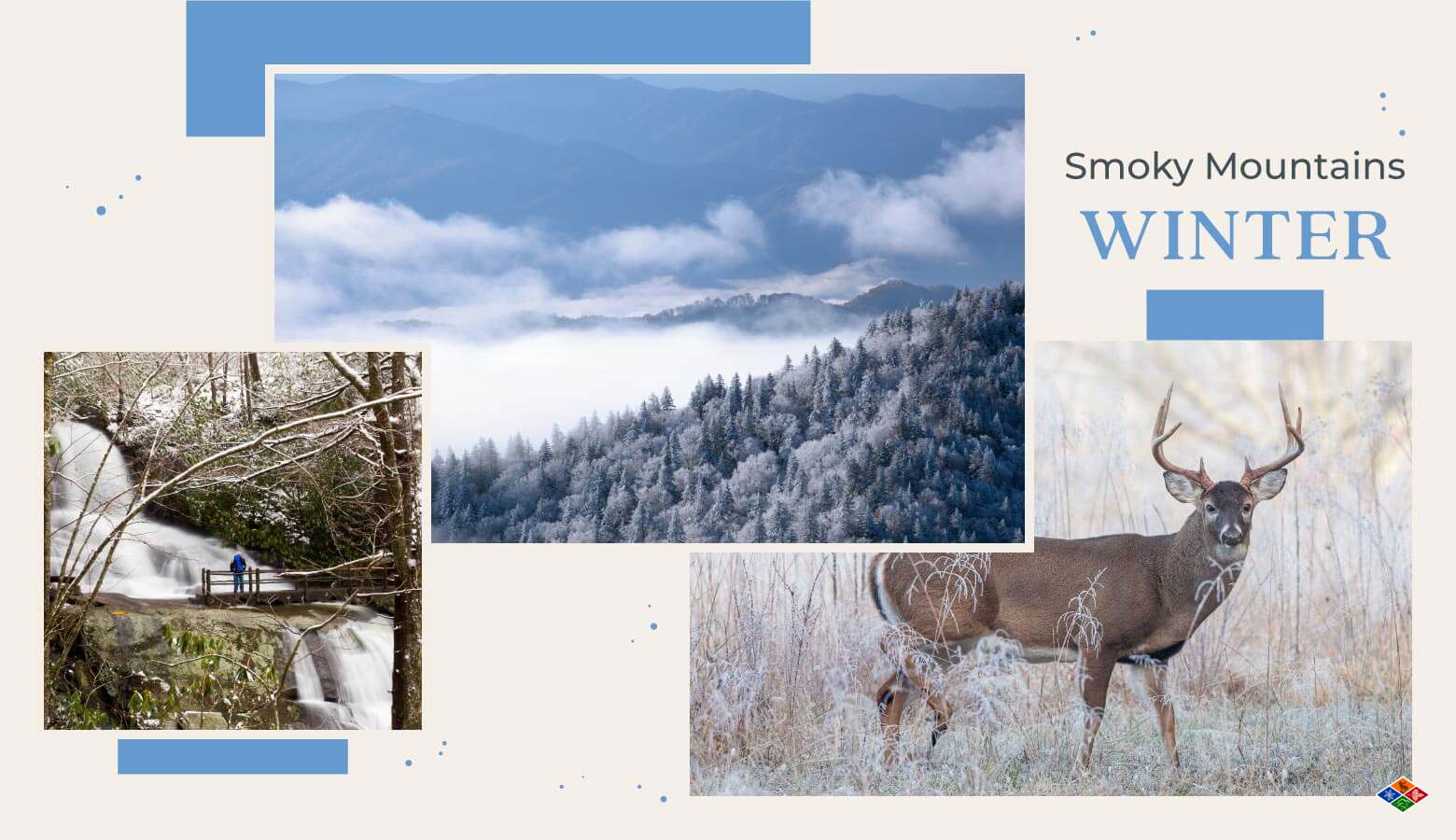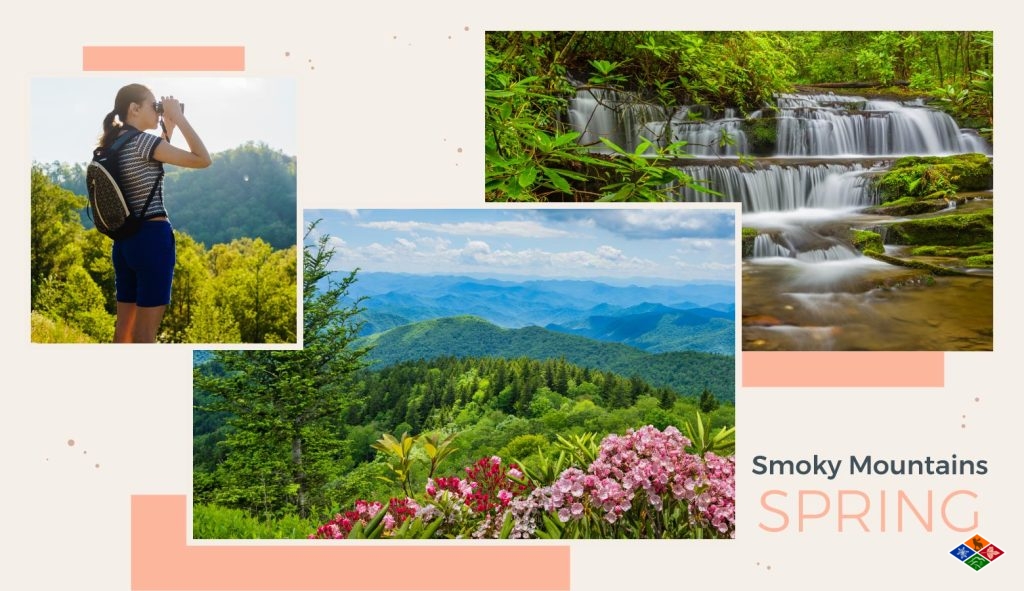
The best time to visit the Smoky Mountains is in the summer months, June, July, and August — with some arguing that October is the best month to visit the Smoky Mountains — according to peak attendance data from the NPS.
With over 500,000 acres of natural beauty, it’s clear why hikers, explorers, and families choose to stay in the Smoky Mountains.
Summer months offer sunny days and warm nights, while the Smoky Mountains in September and sequential autumn months showcase fall foliage as the leaves change color and the rain and humidity fall to some of the year’s lowest levels.
While the summer and fall months are the most popular times to visit, the park is beautiful year-round. Many travelers enjoy the smaller crowds and more affordable prices during the park’s off-season, which runs from late fall to early spring. The park’s serene beauty shines through in the misty trails, frost-tipped peaks, and hidden vistas that emerge as the landscape transforms.
| Gatlinburg, TN (Low Elevation) | Clingmans Dome (High elevation) | |||
| Average High | Average Low | Average High | Average Low | |
| January | 51°F | 28°F | 35°F | 19°F |
| February | 54°F | 29°F | 35°F | 18°F |
| March | 61°F | 34°F | 39°F | 24°F |
| April | 71°F | 42°F | 49°F | 34°F |
| May | 79°F | 50°F | 57°F | 43°F |
| June | 86°F | 58°F | 63°F | 49°F |
| July | 88°F | 59°F | 65°F | 53°F |
| August | 87°F | 60°F | 64°F | 52°F |
| September | 83°F | 55°F | 60°F | 47°F |
| October | 73°F | 43°F | 53°F | 38°F |
| November | 61°F | 33°F | 42°F | 28°F |
| December | 52°F | 28°F | 37°F | 21°F |

Visiting the Smoky Mountains in August and summer months is a great way to experience the best the Smokies can offer. Hot days and cool nights provide the perfect environment for exploring everything in the park, from hiking to swimming and sightseeing.
Successfully booking accommodations for this season should typically happen well in advance — July, for example, is the peak month for visitors. But if you don’t mind the heat and the occasional crowd, summer is one of the best times to visit.
Pros of Visiting in the Summer
Cons of Visiting in the Summer
Depending on your location and elevation in the park, temperatures can reach the mid-to-high 80s during the day and as low as the high 40s at night.
These months are when moisture and humidity are at their highest. This means a low haze often engulfs the peaks during the morning hours, which can often make way for afternoon showers or thunderstorms. But don’t worry — clear skies can be just as common.
The summer months offer many opportunities that make the Smoky Mountains a sought-after destination.
The warm temperature is perfect for exploring the 800 miles of hiking trails throughout the park, zip lining, horseback riding, and general exploring. Embark on sightseeing excursions to find roaming deer and turkeys, or try to find as many of the 1,500 types of wildflowers as you can.
Additionally, one thing that makes this season unique is the water activities. Plan a trip to find a Gatlinburg swimming hole or waterfall, or try your hand at whitewater rafting.

Late fall to early spring offers additional advantages like fewer crowds, several options to stay in the Smokies, and more affordable prices. The Smoky Mountains in November and autumn months offer endless acres of oak, maple, and birch trees erupting with spectacular color, filling the landscape with red, yellow, and orange hues. Also, the park can be more secluded than its peak-season counterparts.
The best time to visit the Smoky Mountains for fall colors is between September and November for a truly picturesque view that rivals any in the country.
Pros of Visiting in the Fall
Cons of Visiting in the Fall
Smoky Mountains weather in the fall welcomes a cooler climate than summer. Depending on the month, temperatures typically fall to the mid-70s during the day and as low as the high-20s by night.
With winter on the horizon, it’s important to know that temperatures will get cooler throughout the season — since September is hotter on average than in November. Despite the occasional cold snap, fall is a very comfortable time, offering low humidity and great weather in the Smoky Mountains for outdoor activities.
During the height of fall coloring, you’ll want to do anything that gets you outside.
The crisp air and mesmerizing views make for the perfect environment to book a pet-friendly cabin in Gatlinburg and hike with your furry friend. Or you can spend an afternoon taking photos. While exploring the endless acres of foliage, you’ll likely find bears, deer, elk, and more actively preparing themselves for winter.
An added dose of magic comes in the form of fall events — Smoky Mountain harvest festivals, apple picking, farmers markets, and more pop up throughout the season in nearby towns such as Gatlinburg and Pigeon Forge.
Sorry, Cabins can’t be previewed in the block editor. You can instead save this post as a draft to preview before publishing.

Looking to take advantage of the best time to visit the Smoky Mountains? Some argue winter is their favorite season. Looking to take advantage of the best time to visit the Smoky Mountains? Some argue winter is their favorite season. With the fewest visitors, you will have easy access to hiking, and with less foliage, you will have wide-open mountain views. Colder temperatures and occasional snowfall can offer those from warmer climates the exciting opportunity to experience snow – and many for the first time. The area offers one of the country’s most elaborate festive and decorative holiday experiences — often including a white Gatlinburg Christmas.
Cold temperatures, slippery roads, and occasional snowfall can put a damper on many of the activities that make the park so special. That said, there are still plenty of opportunities for exploration or winter sports in the more frigid months of the year — December being the most popular for visitors.
Pros of Visiting in the Winter
Cons of Visiting in the Winter
Winter makes a grand entrance in the Smoky Mountains, bringing in sub-freezing weather and draping a layer of snow across the more elevated portions of the park.
The weather in the Smoky Mountains in December and winter months typically ranges from the mid-50s during the day to as low as the high teens by night. It’s important to note that this season is when the varied elevation makes a difference: Lower areas of the park will typically be above freezing during the day, while higher elevations can become blanketed in snow and ice.
Winter provides fewer opportunities for activities in the Smoky Mountains but provides just as much natural beauty.
During this time, many roads, trails, and campsites will be closed for the season due to safety concerns and a lack of visitors. However, the smaller crowds allow you to get lost in a wonderful winter landscape.
Despite the closures, many trails are still open, allowing brave visitors to take a winter hike in the Smokies and explore frozen waterfalls and snow-crested hills in absolute solitude. The area is a great place to be around the holidays, as the nearby Smoky Mountain towns get decked out in holiday decor. Try catching a ride on the Gatlinburg holiday lights trolley ride for holiday sightseeing.

The Smoky Mountains are when the landscape wakes up in the spring months. The snow and ice that moved into the area over the previous months started to melt, making way for running creeks, emerging wildlife, and blooming flowers.
The Great Smoky Mountains in March and other spring months offer an ideal opportunity to explore the Smoky Mountains with fewer crowds, lower prices on accommodations and activities, and plenty of outdoor adventures. Spring is a perfect time to plan a backpacking trip in the Smoky Mountains as the weather starts to warm up.
Visiting during the off-season lets you enjoy the park’s beauty in a more relaxed, peaceful setting. Book your stay early, as May marks the start of the busy season.
Pros of Visiting in the Spring
Cons of Visiting in the Spring
Spring brings in warmer weather than winter, as daytime temperatures typically reach the 60s and 70s while nighttime hovers around the mid-20s.
As with fall, the average temperatures can change substantially from month to month during this season. March is the coldest spring month, while May can even give a welcome glimpse into summer weather.
As the park begins to thaw, there are several unique activities in the spring months.
Creeks and waterfalls start to flow over with some of their highest water levels of the year (perfect for a creekside cabin), wildlife becomes more active, and popular hiking trails open up from their winter closures. The blooming wildflowers and green hillsides also provide the perfect backdrop for sightseeing.
This season is also one of the best for fishing for all the anglers out there, as spring provides the perfect water temperature to catch bass, trout, and more in one of the park’s 2,000 miles of river. Take a day to head to the best fly fishing spots the Smokies offer for a day of relaxation.
Sorry, Cabins can’t be previewed in the block editor. You can instead save this post as a draft to preview before publishing.

While most people think the best time to visit the Smoky Mountains is in summer or fall, there are plenty of reasons to visit this wondrous natural park year-round.
Whether you’re planning a family trip, a romantic getaway, or a vacation with friends, each season brings unique surroundings and experiences that make the area a perfect travel destination throughout the year.
At Elk Springs Resort, we offer many premium Gatlinburg cabins that will make your stay in the Smoky Mountains unforgettable.
Contact us today to get one step closer to booking your dream vacation.